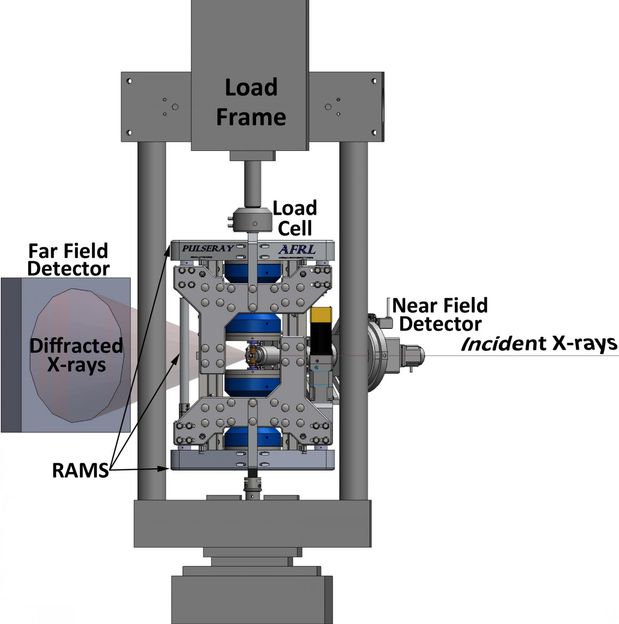A close-up view of materials as they stretch or compress
Advertisement
Materials scientists are busy developing advanced materials, while also working to squeeze every bit of performance out of existing materials. This is particularly true in the aerospace industry, where small advantages in weight or extreme temperature tolerance quickly translate into tremendous performance benefits.

This setup is used for high-energy diffraction microscopy experiments -- it involves a rotational and axial motion system load frame insert in a conventional load frame along with near-field and far-field detectors. The loading axis is vertical, and the specimen and specimen grips rotate around the loading axis while the rest of the setup remains stationary.
Review of Scientific Instruments
The potential pay-offs motivated a team of researchers from the Air Force Research Laboratory, the Advanced Photon Source, Lawrence Livermore National Laboratory, Carnegie Mellon University and PulseRay to work together to pursue their shared goal of characterizing structural materials in unprecedented detail.
The group describes how they created a system to squeeze and stretch a material while at the same time rotating and bombarding it with high-energy synchrotron X-rays. The X-rays capture information about how the material responds to the mechanical stress.
"This required developing a loading system to enable the precise rotation of a sample while simultaneously and independently applying tensile or compressive axial loading," explained Paul A. Shade, lead author and a materials research engineer for the Air Force Research Laboratory at Wright-Patterson Air Force Base.
Their approach included "developing and validating micromechanical models to help us understand the sources of failure in materials so that we can produce aerospace components that are lighter and more damage tolerant -- while also gaining a more complete understanding of their service lifetime capability," Shade added.
The main significance of the team's new tool is that "the RAMS load frame insert enables applying axial loads while the specimen is continuously rotated, which means that we can integrate near-field and far-field high-energy diffraction microscopy methods and microtomography with in situ mechanical testing," said Shade. "This allows us to nondestructively characterize the microstructure and micromechanical state of a deforming material--providing critical validation data for microstructure-sensitive performance-prediction models."
The materials community is interested in using the team's tool as part of an integrated computational materials engineering approach to design structural components - which could help optimize materials properties and reduce uncertainty for given applications. The measurements that this tool enables can be used to develop new materials for turbine engines, car parts and industrial machinery, to name just a few applications.
"An important aspect is to develop trusted materials models whose performance has been validated at the appropriate length scale," Shade said.
Original publication
Paul A. Shade, Basil Blank, Jay C. Schuren, Todd J. Turner, Peter Kenesei, Kurt Goetze, Robert M. Suter, Joel V. Bernier, Shiu Fai Li, Jonathan Lind, Ulrich Lienert and Jonathan Almer; "A rotational and axial motion system load frame insert for in situ high- energy x-ray studies"; Review of Scientific Instruments; 2015

































































